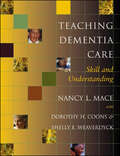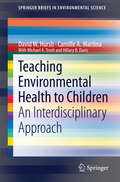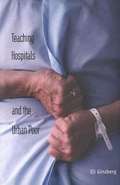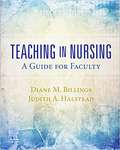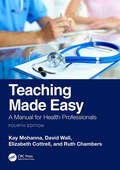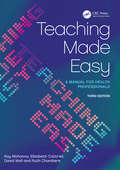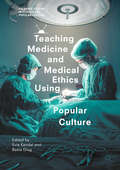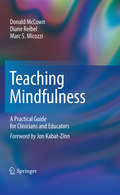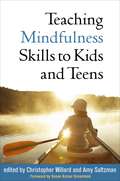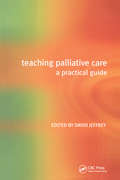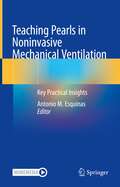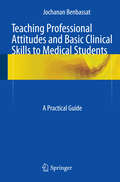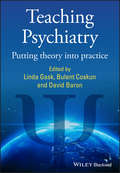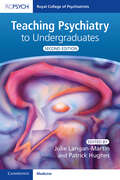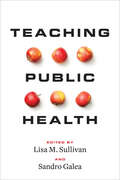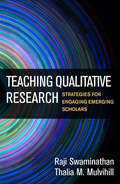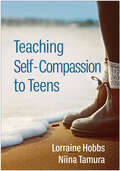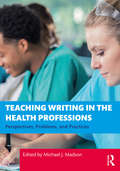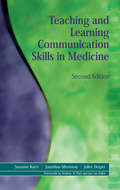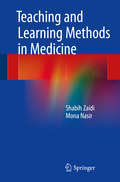- Table View
- List View
Teaching Dementia Care: Skill and Understanding
by Nancy L. MaceDementia afflicts millions of Americans and deeply affects the lives of their loved ones. Good care has been proven to have a significant effect on the quality of life of a person with dementia. To ensure good care, staff members of nursing homes, assisted living facilities, and adult day-care centers, and providers of home care must be thoroughly and continually trained by qualified and well-prepared professionals.Nancy L. Mace, coauthor of The 36-Hour Day, has created the ultimate teachers' guide for dementia care training. Rich with information and with tools for effective communication between teacher and student, the text supplies instructors with in-depth lessons and includes relevant charts, tables, and handouts, which may be customized to suit specific programs. Good training is the foundation for a confident and competent caregiver and supports the dignity and well-being of persons with dementia and their families. With her unmistakable compassion, humor, and wisdom, Mace has provided a much-needed guidebook for better teaching and better care.
Teaching Environmental Health to Children
by David W. Hursh Hilarie B. Davis Camille A. Martina Michael A. TrushEvery day we are exposed to toxins and toxicants that can impact our health. Yet we rarely teach elementary and secondary students about these exposures and how they can reduce their risk to them. In this book we highlight activities and curriculum developed at nine universities in the United States from a grant funded by the National Institute of Environmental Health Sciences. Our goal is to extend these lessons to a global audience and for classroom teachers of all subjects and age levels to include environmental health in their teaching. 'An invaluable tool for equipping informed citizens to think about the environment and its human impacts --both the science, and equally important, the social and ethical dimensions' , Howard Frumkin, M.D., Dr. P.H., Dean, School of Public Health, University of Washington, Seattle, WA, USA
Teaching Health Professionals Online: Frameworks and Strategies
by Beth Perry Sherri Melrose Caroline ParkTeaching Health Professionals Online: Frameworks and Strategies is a must-read for professionals in the health care field who strive to deliver excellence in their online classes. Intended for a wide range of professionals, including nurses, social workers, occupational and radiation therapists, chiropractors, dietitians, and dental hygienists, this compendium of teaching strategies will inspire both new and experienced instructors in the health professions. In addition to outlining creative, challenging activities with step-by-step directions and explanations of why they work, each chapter in the text situates practice within the context of contemporary educational theories such as instructional immediacy, invitational theory, constructivism, connectivism, transformative learning, and quantum learning theory. Melrose, Park, and Perry also address other issues familiar to those who have taught online courses. How can a distance instructor build teacher-student relationships? How does one transform the assumptions often held by students in the health fields from the confines of the virtual classroom? Most importantly, how can the instructor support his or her students in their future pursuits of knowledge and their development as competent professionals? By considering these and other concerns, this handbook aims to help instructors increase student success and satisfaction, which, the authors hope, will ultimately produce the best possible patient care.
Teaching Hospitals and the Urban Poor
by Eli GinzbergAcademic health centers (AHCs) have played a key role in propelling the United States to world leadership in technological advances in medicine. At the same time, however, many of these urban-based hospitals have largely ignored the medical care of their poor neighbors. Now one of the leading experts in American health policy and economics ponders whether current and proposed changes in the financing and delivery of medical care will result in a realignment between AHCs and the poor. Basing his discussion on an analysis of the nation's twenty-five leading research-oriented health centers, Eli Ginzberg and his associates trace the history of AHCs in the twentieth century. He claims that AHCs are once again moving toward treating the poor because these hospitals need to admit more Medicaid patients to fill their empty beds, and their medical students need opportunities to practice in ambulatory sites. He also assesses some of the more important trends that may challenge the AHCs, including financial concerns, changing medical practice environments, and the likelihood of some form of universal health insurance.
Teaching In Nursing: A Guide For Faculty
by Diane M. Billings Judith A. HalsteadThe perfect all-in-one guide for future nurse educators! The award-winning Teaching in Nursing: A Guide for Faculty, 6th Edition prepares you for the day-to-day challenges of teaching future nurses for practice in today's rapidly evolving healthcare system. This comprehensive resource is the only one of its kind to cover all four components of nursing education: teaching and learning, curriculum, evaluation, and technology-empowered learning. You’ll benefit from the expert guidance on such key issues as curriculum and test development, diverse learning styles, the redesign of healthcare systems, and advances in technology and information. Plus, the 6th edition includes a unique new chapter on Global Health and Curricular Experiences along with updated information on technology-empowered learning, the flipped classroom, interprofessional education, interprofessional collaborative practice, and much more.
Teaching Made Easy: A Manual for Health Professionals
by Kay Mohanna Elizabeth Cottrell David Wall Ruth ChambersThe fourth edition of this highly respected book builds on the excellent reputation of its predecessors. Fully revised and updated throughout, it continues to provide essential structure, support, guidance and tips for both beginning and experienced teachers and their managers, both in the UK and internationally. Pitched at an introductory level with an emphasis on practical tips and application of theory, rather than focussing heavily on scholarly research, its content is designed to be relevant and inclusive to all healthcare disciplines. Key points are highlighted by the inclusion of tips from experienced teachers in each chapter, while throughout chapters reflect contemporary concepts and key approaches, including teaching styles, curriculum development, e-learning, virtual learning environments, leadership and professionalism. Teaching Made Easy, 4E will continue to benefit everyone teaching health professionals at all levels, from general practitioners and hospital doctors, nurses in primary and secondary care, and professionals allied to medicine and health service managers, and will also support the development of colleagues in new roles such as physician associates, FCPs and newer nursing associates.
Teaching Made Easy: A Manual for Health Professionals, 3rd Edition
by Kay Mohanna Elizabeth Cottrell David Wall Ruth ChambersThe Third Edition of this highly respected book has been further refined following feedback and consultation; it continues to provide essential structure, support, guidance and tips for both beginning and experienced teachers and their managers. The new edition has been developed for use by both UK and international teachers. Its content is designed to be relevant and inclusive to all healthcare disciplines, and has been thoroughly reorganised to ensure more intuitive placement of information. Key points are highlighted by the new inclusion of Tips from experienced teachers in each chapter, while newly-written chapters reflect contemporary concepts and key approaches, including teaching styles, curriculum development, e-learning, virtual learning environments, leadership and professionalism. This book will continue to benefit everyone teaching health professionals at all levels, including general practitioners and hospital doctors, nurses in primary and secondary care, professionals allied to medicine and health service managers. From reviews of previous editions: 'A useful book for those with a genuine interest in the full gamut of education' - ANNALS OF THE ROYAL COLLEGE OF SURGEONS OF ENGLAND 'Comprehensive and easy to understand. If you are looking for a book that will help you develop your teaching skills and to open your mind to the broader aspects of teaching in the healthcare setting then this is a gem not to be missed. For once it is a book that lives up to its title.' - SCOTTISH JOURNAL OF HEALTHCARE CHAPLAINCY 'A book which has a considerable relevance for community practice teachers whatever their nursing discipline. The strength of the book is its practical approach to guiding and assessing students in the practice setting.' - JOURNAL OF COMMUNITY NURSING
Teaching Medical Professionalism
by Yvonne Steinert Richard L. Cruess Sylvia R. Cruess Cruess, Richard L. and Cruess, Sylvia R. and Steinert, YvonneUntil recently professionalism was transmitted by respected role models, a method that depended heavily on the presence of a homogeneous society sharing values. This is no longer true, and medical schools and postgraduate training programs in the developed world are now actively teaching professionalism to students and trainees. In addition, licensing and certifying bodies are attempting to assess the professionalism of practising physicians on an ongoing basis. This is the only book available to provide guidance to those designing and implementing programs on teaching professionalism. It outlines the cognitive base of professionalism, provides a theoretical basis for teaching the subject, gives general principles for establishing programs at various levels (undergraduate, postgraduate, and continuing professional development), and documents the experience of institutions who are leaders in the field. Teaching aids that have been used successfully by contributors are included as an appendix and are available in downloadable form on our website.
Teaching Medical Professionalism
by Richard L. Cruess Sylvia R. Cruess Yvonne Steinert Richard L. Cruess Sylvia R. CruessUntil recently professionalism was transmitted by respected role models, a method that depended heavily on the presence of a homogeneous society sharing values. This is no longer true, and medical schools and postgraduate training programs in the developed world are now actively teaching professionalism to students and trainees. In addition, licensing and certifying bodies are attempting to assess the professionalism of practicing physicians on an ongoing basis. This is the only book available to provide guidance to those designing and implementing programs on teaching professionalism. It outlines the cognitive base of professionalism, provides a theoretical basis for teaching the subject, gives general principles for establishing programs at various levels (undergraduate, postgraduate, and continuing professional development), and documents the experience of institutions who are leaders in the field. Teaching aids that have been used successfully by contributors are included as an appendix and are available in downloadable form on our website.
Teaching Medicine and Medical Ethics Using Popular Culture
by Evie Kendal Basia DiugThis book demonstrates how popular culture can be successfully incorporated into medical and health science curriculums, capitalising on the opportunity fictional media presents to humanise case studies. Studies show that the vast majority of medical and nursing students watch popular medical television dramas and comedies such as Grey's Anatomy, ER, House M. D. and Scrubs. This affords us with a unique opportunity to engage and inform not only students but the general public and patients further downstream. This volume analyses examples of medical-themed popular culture and offers various strategies and methods for educators in this field to integrate this material into their teaching. The result is a fascinating read and original resource for medical professionals and teachers alike.
Teaching Mindfulness
by Donald Mccown Diane K. Reibel Marc S. MicozziThe applications and use of mindfulness-based interventions in medicine, mental health care, and education have been expanding as rapidly as the empirical evidence base that is validating and recommending them. This growth has created a powerful demand for professionals who can effectively deliver these interventions, and for the training of new professionals who can enter the fold.Ironically, while the scientific literature on mindfulness has surged, little attention has been paid to the critical who and how of mindfulness pedagogy. Teaching Mindfulness is the first in-depth treatment of the person and skills of the mindfulness teacher. It is intended as a practical guide to the landscape of teaching, to help those with a new or growing interest in mindfulness-based interventions to develop both the personal authenticity and the practical know-how that can make teaching mindfulness a highly rewarding and effective way of working with others. The detail of theory and praxis it contains can also help seasoned mindfulness practitioners and teachers to articulate and understand more clearly their own pedagogical approaches. Engagingly written and enriched with vignettes from actual classes and individual sessions, this unique volume: Places the current mindfulness-based interventions in their cultural and historical context to help clarify language use, and the integration of Eastern and Western spiritual and secular traditionsOffers a highly relational understanding of mindfulness practice that supports moment-by-moment work with groups and individualsProvides guidance and materials for a highly experiential exploration of the reader's personal practice, embodiment, and application of mindfulness Describes in detail the four essential skill sets of the mindfulness teacher Proposes a comprehensive, systematic model of the intentions of teaching mindfulness as they are revealed in the mindfulness-based interventionsIncludes sample scripts for a wide range of mindfulness practices, and an extensive resource section for continued personal and career development Essential for today's practitioners and teachers of mindfulness-based interventionsTeaching Mindfulness: A Practical Guide for Clinicians and Educators brings this increasingly important discipline into clearer focus, opening dialogue for physicians, clinical and health psychologists, clinical social workers, marriage and family therapists, professional counselors, nurses, occupational therapists, physical therapists, pastoral counselors, spiritual directors, life coaches, organizational development professionals, and teachers and professionals in higher education , in short, everyone with an interest in helping others find their way into the benefits of the present moment.
Teaching Mindfulness Skills to Kids and Teens
by Susan Kaiser Greenland Christopher Willard Amy SaltzmanPacked with creative, effective ideas for bringing mindfulness into the classroom, child therapy office, or community, this book features sample lesson plans and scripts, case studies, vignettes, and more. Leading experts describe how to harness the unique benefits of present-focused awareness for preschoolers, school-age kids, and teens, including at-risk youth and those with special needs. Strategies for overcoming common obstacles and engaging kids with different learning styles are explored. Chapters also share ways to incorporate mindfulness into a broad range of children's activities, such as movement, sports, music, games, writing, and art. Giving clinicians and educators practices they can use immediately, the book includes clear explanations of relevant research findings.
Teaching Palliative Care: A Practical Guide
by David JeffreyEducation of healthcare professionals is the cornerstone of specialist palliative services. This book is a practical toolbox of teaching techniques. Accessible, practical and easy to use it will encourage busy clinicians to teach by increasing their confidence in their training abilities. It provides a resource of various tools and describes how to approach teaching in a team, planning, methods and evaluation. Each chapter presents a menu of tried and tested techniques and closes with examples of lesson plans. The multidisciplinary experiences of the contributors are reflected in the book and healthcare professionals working in palliative care, hospitals, hospices or the community will find it to be essential reading.
Teaching Pearls in Noninvasive Mechanical Ventilation: Key Practical Insights
by Antonio M. EsquinasThis book uses real-world clinical case analyses of hot topics to provide insights into noninvasive mechanical ventilation (NIV). Written by leading international teachers and experts, it features a selection of “major controversial topics in clinical practice” and demonstrates how these cases can be used to teach about NIV. It then presents a discussion of the topics in various scenarios (anesthesiology, critical care, emergency, pneumology and sleep medicine, as well). The chapters allow readers to develop a case-by-case understanding of NIV in acute and chronic respiratory disorders, and perioperative and in intensive care patients, also thanks to Electronic Supplementary Materials. Lastly the authors summarize five key points / recommendations. This book is an attractive resource also for universities / educational seminars / national and international postgraduate courses and hot-topics sessions at national/international congresses.
Teaching Professional Attitudes and Basic Clinical Skills to Medical Students
by Jochanan BenbassatThis concise, easy to read title is designed for clinical teachers looking to refine their approach to teaching professional attitudes and basic skills to medical students. Doctors differ in values, training and practice setting, and eventually they adopt diverse approaches to patient interviewing, data collection and problem-solving. As a result, medical students may encounter significant differences in the clinical methods of their tutors. For example, some doctors encourage patients' narratives by using open-ended questions while others favor closed-questions; and hospital- and community-based doctors may disagree on the value of the physical examination. Medical students may be puzzled by these differences and by controversies about issues, such as doctor-patient relations and the approaches to clinical reasoning. This handy title is intended to help tutors address many of these issues, and to provide an approach not only to teaching patient interviewing and the physical examination but to teaching some clinically relevant topics of the behavioral and social sciences that are so vital to developing an effective, well-rounded physician.
Teaching Professional Attitudes and Basic Clinical Skills to Medical Students: A Practical Guide
by Jochanan BenbassatThe second edition of this concise, easy-to-read title is designed for clinical teachers looking to refine their approach to teaching professional attitudes and basic skills to medical students. The core sections on communication skills, physical examination, and clinical reasoning have been fully updated; and the book has been expanded to cover such topics as the role of the social and behavioral sciences in clinical care, quality assurance of patient care, and the rationing of medical resources in clinical practice. On all topics, the renowned author clearly and adroitly offers keen insights gleaned from his long career, explaining the importance of these topics and how students form their own opinions about them. For example, writes the author, the primary goal of teaching the social and behavioral sciences is to raise awareness that age, low socioeconomic status, recent life events, drug dependence, mental illness, high body mass index, and belonging to an ethnic minority are risk indicators for morbidity. Second, the author address second opinions, outlining how not getting a second opinion is a cause of health care disparities. In addition, the author discusses how unexpected study results should not be ignored, nor should they be considered definitive evidence, but rather hypotheses that should be tested by further studies. Teaching Professional Attitudes and Basic Clinical Skills to Medical Students: A Practical Guide, 2nd Edition will be of great assistance to teachers who must provide an approach not only to teaching patient interviewing and the physical examination but to teaching key, clinically relevant topics of the behavioral and social sciences that are so vital to developing an effective, well-rounded physician.
Teaching Psychiatry
by Bulent Coskun Linda Gask David A. BaronIn psychiatry, as in all of medicine, clinicians are frequently involved in training students and residents yet few have themselves been trained in pedagogy. Improving the quality of psychiatric education should both improve the quality of psychiatric care and make the profession more attractive to medical students. Written by a team of international experts with many years of experience, this comprehensive text takes a globally relevant perspective on providing practical instruction and advice on all aspects of teaching psychiatry. It covers learning from undergraduate and postgraduate level to primary medical and community settings, enabling readers to find solutions to the problems they are facing and become aware of potential issues which they can anticipate and be prepared to address. The book discusses curriculum development using examples from around the world, in order to provide trainees with the basic attitudes, knowledge and skills they require to practise psychiatry.Features:Instruction on developing a curriculum for Residency training, teaching interviewing skills, teaching psychotherapy and using new technologyInnovative ways of engaging medical students in psychiatry and developing their interest in the specialty, including experience with new types of elective and research options and development of roles for students in patient careFocuses throughout on how to teach rather than what to teachIncludes descriptions of workplace-based assessmentsDiscussions of both theoretical and practical perspectives and examples of particular innovations in the field using case studiesPresented in a thoroughly readable and accessible manner, this book is a primary resource for all clinicians involved in teaching psychiatry to medical students and trainees.
Teaching Psychiatry to Undergraduates
by Patrick Hughes Julie Langan MartinPsychiatry requires a unique blend of knowledge, skills and attitudes, with important ethical and philosophical issues intrinsic to the specialty. Although teaching is an important part of training and working as a psychiatrist, this is often carried out without any specific training in educational theory or practice. This book teaches readers how to apply educational theory in this complex setting to provide the best possible learning experience for students. Chapters are short and focused, allowing the busy psychiatrist or other professional involved in undergraduate psychiatry teaching to pick it up, absorb some of the principles, and start applying them straight away to improve their teaching. Contributions from individuals with lived experience throughout the book provide insight into the patient experience and how this can be sensitively and effectively incorporated into undergraduate teaching and the benefits that can be gained from doing so.
Teaching Public Health
by Lisa M. Sullivan and Sandro GaleaA comprehensive collection of best practices in public health education.As more students are drawn to public health as a field of study and a profession, bringing varied backgrounds and experiences with them, the number of public health programs and schools of public health has grown substantially. How can teachers meet the changing needs of incoming students—and ensure that graduates have the knowledge, skills, and attributes to pursue further education and forge successful careers in public health? Aimed at experienced and new teachers alike, this timely volume is a cutting-edge primer on teaching public health around the globe. Bringing together leaders in the field with expertise across the educational continuum, the book combines the conceptual underpinnings needed to advance curricula with the resources to train and support faculty in innovative teaching methods. This thorough book • discusses challenges faced by public health teachers• examines the principles and practices for teaching at each level of study• describes technological and pedagogical innovations in public health education• stresses the importance of life-long learning and interprofessional education• offers concrete tips for engaging students through active and collaborative learning• focuses on teaching cultural competency and reaching diverse student populations• looks to the future, building on emerging trends and anticipating where the field is headedA field-defining volume, Teaching Public Health offers a concrete plan to ensure that both individual courses and overall curricula are responsive to the needs of a rapidly changing student body and the world beyond the school.Contributors: Linda Alexander, Susan Altfeld, Jessica S. Ancker, Lauren D. Arnold, Melissa D. Begg, Angela Breckenridge, Kathryn M. Cardarelli, Angela Carman, Trey Conatser, Lorraine M. Conroy, Yvette C. Cozier, Eugene Declercq, Marie Diener-West, Jen Dolan, Greg Evans, Julian Fisher, Elizabeth French, Sandro Galea, Daniel Gerber, Sophie Godley, Jacey A. Greece, Perry N. Halkitis, Jennifer Hebert-Beirne, Jyotsna Jagai, Katherine Johnson, Nancy Kane, David G. Kleinbaum, Wayne LaMorte, Meg Landfried, Delia L. Lang, Joel Lee, Laura Linnan, Laura Magaña Valladares, Uchechi Mitchell, Beth Moracco, Robert Pack, Donna Petersen, Silvia E. Rabionet, Elizabeth Reisinger Walker, Richard Riegelman, Kathleen Ryan, Nelly Salgado de Snyder, Rachel Schwartz, Lisa M. Sullivan, Tanya Uden-Holman, Luann White, James Wolff, Randy Wykoff
Teaching Qualitative Research: Strategies for Engaging Emerging Scholars
by Raji Swaminathan Thalia M. MulvihillThis timely resource provides a framework for teaching students how to think qualitatively and become more critical and reflexive researchers. Presented are a wealth of pedagogical tools that instructors across the disciplines can tailor to their own needs, including thought-provoking discussion questions, group work exercises, and field activities. The authors discuss issues and choices in course design, including approaches to assessment and grading, and share sample syllabi for both online and face-to-face course formats. Exploring the complexities and debates that surround teaching qualitative research, the book argues for a holistic model of preparing novice researchers. It demonstrates effective ways to engage students in the qualitative inquiry process from start to finish--from understanding positionality and crafting a research problem to writing up findings for different audiences.
Teaching Self-Compassion to Teens
by Lorraine Hobbs Niina TamuraGrounded in knowledge about the unique developmental challenges of adolescence, this book presents an innovative approach for teaching self-compassion to teens and young adults in clinical, educational, or community settings. Lorraine Hobbs and Niina Tamura provide guided practices, creative exercises, and teaching strategies adapted from Kristin Neff and Christopher Germer&’s widely disseminated Mindful Self-Compassion program for adults. Case examples, sample dialogues, and scripts illustrate how to set up and run successful groups that address teen concerns such as self-criticism, self-esteem, social comparison, and strong emotions. The book offers guidelines for cultivating a personal practice and working with parents. Tips for providing a safe, effective learning environment are woven throughout; a special chapter covers trauma-sensitive teaching.
Teaching Students Geriatric Research
by Kathryn Braun Margaret A PerkinsonTeach your students essential skills in conducting research, building collaborative partnerships, and working with clients and caregivers!This important book provides health care educators with information, examples, and suggestions to help teach students appropriate research techniques amidst a growing demand for evidence-based practices. Offering two effective and efficient methods, the apprenticeship model and the partnership model, Teaching Students Geriatric Research will show you how to incorporate these research fundamentals in an already heavy courseload. By providing conceptual rationales and guidelines for these models and directions on how to use them, this thorough guide will assist you in enhancing research training for your students and preparing them for a career in the health professional field. Through this unique book, you will find clear descriptions and illustrations of the apprenticeship and partnership models of research to help you provide your students with a hands-on leaning experience. Teaching Students Geriatric Research provides you with guidelines and suggestions on how to successfully use both models of training described in this book, such as: exploring guidelines for training students and incorporating them into ongoing research discussing students’reflections on the relevance of research training for professional development based on their own experiences as research apprentices discovering the various skills that students can develop as a result of their involvement in research training apprenticeships finding that the skills students learn through the research process will benefit their future clinical practice and client intervention realizing how students’research apprenticeship can sensitize them to family caregiving issues and problems alerting students to the potential role of occupational therapists in enhancing occupational performance by maximizing fit between the caregiver, environment, and roles or occupation by matching the personality of the caregiver with their occupation examining useful and concrete suggestions on developing fruitful partnerships between faculty, students, and service providers, as well as discussing the factors involved in the successes of collaboration from an already existing collaboration between rehabilitation hospital and a major universityWith Teaching Students Geriatric Research, you will discover the potential in each approach for improving the research training among students in your academic situation. You will gain valuable insight from student perspectives on what they learned as well as proven suggestions from faculty researchers’perspective to provide you with a complete overview of how to enhance and enrich the academic experiences of your students.
Teaching Writing in the Health Professions: Perspectives, Problems, and Practices
by Michael J. MadsonThis collection provides a research-based guide to instructional practices for writing in the health professions, promoting faculty development and bringing together perspectives from writing studies, technical communication, and health humanities. With employment in health-care sectors booming, writing instruction tailored for the health professions is in high demand. Writing instruction is critical in the health professions because health professionals, current and aspiring, need to communicate persuasively with patients, peers, mentors, and others. Writing instruction can also help cultivate professional identity, reflective practice, empathy, critical thinking, confidence, and organization, as well as research skills. This collection prepares faculty and administrators to meet this demand. It combines conceptual development of writing for the health professions as an emergent interdiscipline with evidence-based practices for instructors in academic, clinical, and community settings. Teaching Writing in the Health Professions is an essential resource for instructors, scholars, and program administrators in health disciplines, professional and technical communication, health humanities, and interdisciplinary writing studies. It informs the teaching of writing in programs in medicine, nursing, pharmacy and allied health, public health, and other related professions.
Teaching and Learning Communication Skills in Medicine
by Jonathan Silverman Suzanne Kurtz Juliet DraperThis book and its companion, Skills for Communicating with Patients, Second Edition, provide a comprehensive approach to improving communication in medicine. Fully updated and revised, and greatly expanded, this new edition examines how to construct a skills curricular at all levels of medical education and across specialties, documents the individuals skills that form the core content of communication skills teaching programmes, and explores in depth the specific teaching, learning and assessment methods that are currently used within medical education. Since their publication, the first edition of this book and its companionSkills for Communicating with Patients, have become standards texts in teaching communication skills throughout the world, 'the first entirely evidence-based textbooks on medical interviewing. It is essential reading for course organizers, those who teach or model communication skills, and program administrators.
Teaching and Learning Methods in Medicine
by Shabih Zaidi Mona NasirThis book considers the evolution of medical education over the centuries, presents various theories and principles of learning (pedagogical and andragogical) and discusses different forms of medical curriculum and the strategies employed to develop them, citing examples from medical schools in developed and developing nations. Instructional methodologies and tools for assessment and evaluation are discussed at length and additional elements of modern medical teaching, such as writing skills, communication skills, evidence-based medicine, medical ethics, skill labs and webinars, are fully considered. In discussing these topics, the authors draw upon the personal experience that they have gained in learning, teaching and disseminating knowledge in many parts of the world over the past four decades. Medical Education in Modern Times will be of interest for medical students, doctors, teachers, nurses, paramedics and health and education planners.
